Now that Samus has walked directly into a deadly waiting trap, springing its cruel jaws into action around her, how will she ever survive? Oh, right… by shooting everything in sight. The Space Pirates are an interesting bunch; they’re agile, capable of climbing walls and leaping around, and they can emit lasers from their bodies. But they’re also not very durable. One shot takes them out. Though there’ll be tougher pirates to deal with in due time.
The ambush room actually turns out to be a pretty dumb place for the pirates to ambush Samus, since its unusually convoluted terrain — the entire chamber is effectively compartmentalized by the burnt-out sockets of the Zebetites — puts the pirates at a disadvantage. You can drop pretty easily into the channels between Zebetite plugs while the pirates muddle around above you. You have to take them all out before you can advance, which means practically the only thing missing is a close-cropped cut of Samus’ visor and she rumbles, “Now you’re locked in here with me.” But this was the good ol’ days before the series loaded itself down with stupid dialogue and cut scenes, so instead you just shoot all the bad guys and move along.
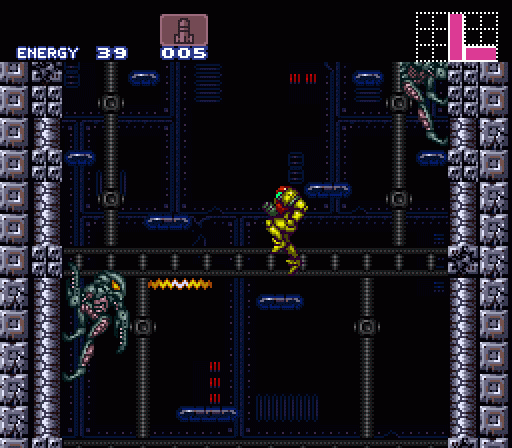
The pirates have infested the former Mother Brain escape shaft, which recontextualizes this piece of scenery for the second time. It’s gone from being nerve-wracking test of dexterity and jumping, to a haunted ruin, to a running fight. The lack of a time limit keeps this area from being as intense as it was in Metroid, but the addition of combat to the upward climb does add an interesting new element to it.
The pirates will shoot at Samus and then leap across the shaft to the other wall if Samus tries to face them on their own level. So this area really becomes an exercise in learning to make the most of Samus’ new ability to aim at a 45-degree angle. You can’t shoot the pirates from directly below because none of the shaft’s platforms line up against the walls, and it’s dangerous to tackle them on their own level. But you can easily stand below them at an angle and fire up to take them out before they’re ever aware of her presence. This sequence goes from tricky to trouble-free once you sort that out.
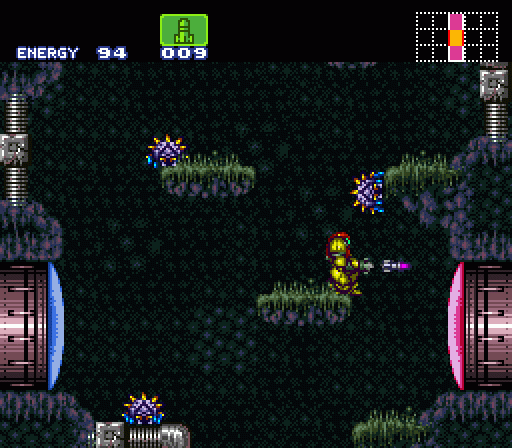
Back on the surface of Zebes (Crateria), a number of enemies have appeared where it was all empty before. The tradeoff, however, is that now you have missiles and the ability to roll into a ball.
The missiles allow you to access a door you couldn’t reach before. Technically, you could have opened this door the moment you collected your first missile, but I have trouble imagining anyone would deliberately backtrack from the ruins of Norfair right away. Between the eerie atmosphere of that area and that lengthy descent down the former escape shaft, the game really nudges you to poke around as much as possible in that area before forcing you to return to Crateria. So unless you’re just deeply obsessive-compulsive about backtracking as soon as possible, you most likely won’t open this door until your return trip to Crateria.
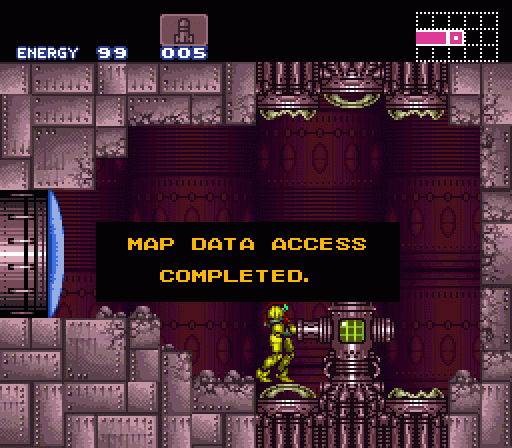
Inside the door is something new for the Metroid games: A map room. The game has been creating an abstracted mini-map as you’ve explored so far, one based almost entirely on the graph paper method I used to chart out the original Metroid (one room per grid square). The map room reveals some but not all of the current area’s rooms — some main thoroughfares are deliberately left blank, while in other cases you’ll see isolated rooms with a dot denoting an item but no obvious route to reach it.
By exposing some but not all of the game’s ground to you, the map data gives you a rough sense of how much turf you need to cover while providing occasional nudges to explore. The fact that you’ll naturally uncover rooms that aren’t auto-charted in the course of the core adventure teaches you not to treat the map data as hard fact, and the dangling carrot of unconnected or seemingly inaccessible rooms coaxes you to search when it’s important.
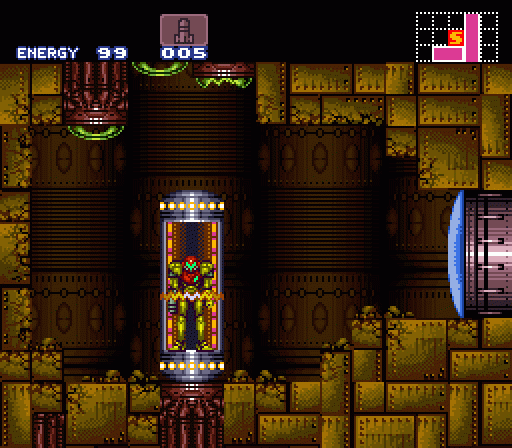
Opposite the map data is a room where you can now roll into a gap in the wall… but you still can’t advance forward, because there’s an obstruction in the way. Above that, however, is the game’s first save room.
You will quickly come to realize that save rooms are located in close proximity to dangerous encounters.

With the Morphing Ball in hand, Samus can roll into a small gap that she had to pass up on her way in. Now, you can drop down and see what’s below. If you choose to drop down, in fact, you have to see what’s below, because the exit is blocked with obstructions you can’t currently destroy.
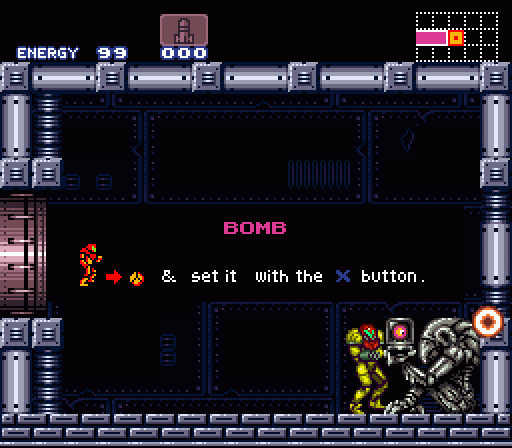
Thankfully this is easily remedied — the alcove below features a room where you can collect Samus’ Bomb power-up, which proves remarkably effective at destroying blocks that mere bullets and missiles can’t.
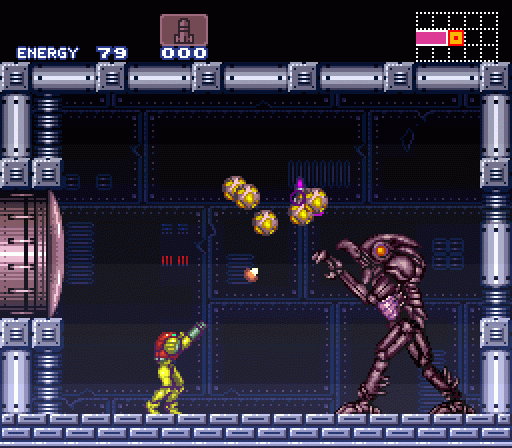
Well, this is a fine how-do-you-do.
Once you grab the bomb, the door locks and the Chozo statue that held the power-up comes to life and attacks. Is this some kind of security system that Samus missed her first time on Zebes? Was it rigged up by the space pirates as a booby trap? It doesn’t really matter; the important thing is that you really can’t let your guard down at all in Super Metroid. This is a nasty sort of extension of the damaged Chozo near the end of Metroid II — power-up rooms as meaningful messages. But you’ll find all kinds of interesting surprises with the Chozo in this game, and this is simply a start.
It can be a pretty tough start, too. The mad Chozo (technically, a Torizo) fires beams at Samus while marching toward her, swinging its arms. Once it’s pushed her to the left edge of the room, it leaps back to the right and begins advancing again, often spewing projectiles that look like the orbs that contain power-ups. If you shoot these balls out of the air, you can usually score some valuable power-ups.
The Torizo takes pretty much a full battery of missiles to destroy, so you most likely need to collect the energy drops left behind by the orbs. If you haven’t learned to quick-switch between cannon and missiles, this is where you should sort it out. There’s a pretty good chance this battle will catch a newcomer unaware and bring their adventure to a swift halt, but since the save room was a short distance away, any loss of time will be minor and it’s no real trouble to try again until you defeat the sentry.

With the Bomb equipped, you can detonate your way back to the main area and roll to freedom. This is a trick you’ll see used over and over again in Super Metroid: Just about every power-up is locked behind a point of no return which can only be bypassed by using that new skill. And so, you can’t leave the area where the bomb is located without first collecting the bomb and figuring out how to use it.
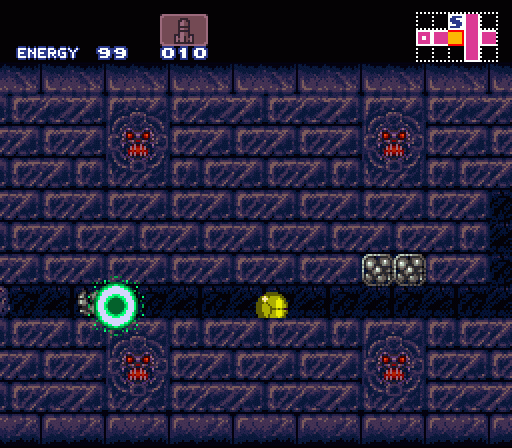
You can return to spots that taunted you with their inaccessibility; in this case, the obstructed conduit opposite the map data room leads you to a missile expansion.

You can return to the surface and try exploring what’s on the other side of Samus’ ship. Sadly, it turns out to be just a green missile door, which Samus currently lacks the ability to prise open.

If you’re feeling really sassy, you can return to where Mother Brain used to reside and bomb beneath her pedestal for another missile expansion. Why was Mother Brain hiding a missile upgrade for Samus? I don’t know, but I bet someone’s written a fan fiction that contains a crackpot (and most likely erotic) theory about it.

The correct solution, however, is to head further to the left of Samus’ ship. This also is the only solution. Super Metroid is actually quite linear in these opening areas, offering just enough lip service to freedom and choice to make you feel like you’re exploring rather than being funneled along a limited critical path. It’s a deft trick of level design.
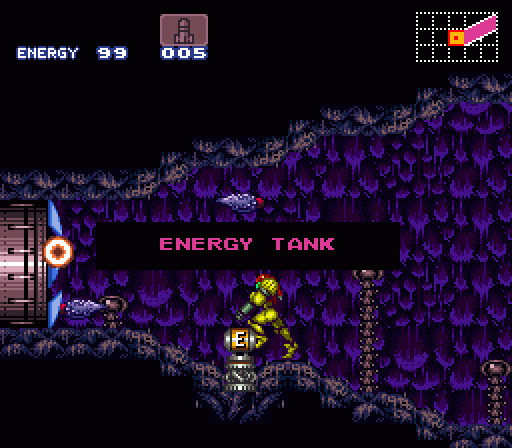
Though the developers sometimes tip their hand a bit when they do things like leave a precious Energy Tank sitting on the ground right in your path. Where’s the sport in having it handed to you?
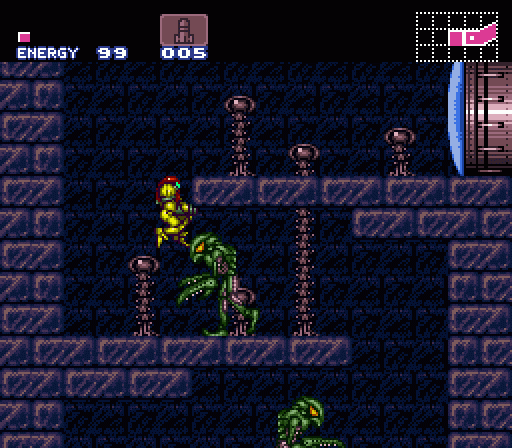
The forward path takes you down again, this time winding through a convoluted shaft that forces you to run constantly left and right along pathways patrolled by space pirates. These are the game’s first space pirate variants, actually — they’re a slightly brighter green than the ones that ambushed you, and they’re trickier to defeat. They don’t jump around as much, but they have the ability to block Samus’ arm cannon. Standard shots won’t hurt them, even if you attack from behind; they’ll pivot quickly and defend. You can destroy them slowly with bombs, or you can just switch to missiles and blast them in the face. Simple, but effective.
Still, the fact that these enemies have proven to be recurring, and the fact that they have different capabilities and defenses than the pirates you’ve already faced, leads you on your first step to facing the dreaded golden pirates quite some ways down the road.
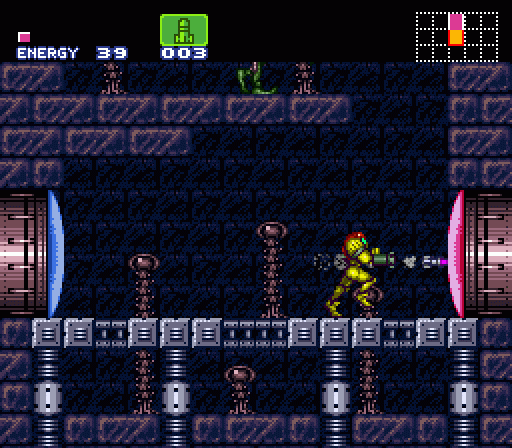
At the bottom of the pirate’s twisted path is a red missile door that proves to be your first map anomaly: The room behind this door doesn’t show up on your map data. Yet there’s no missing this door and the fact that something is here. Not only should this be your first major tip-off to the incomplete nature of the map room info, it should also pique your exporer’s curiosity. What lurks here, anyway?
The answer, it turns out, is an empty corridor wreathed in the same haze that the ruins of Tourian were before the space pirate ambush. That could be mere atmosphere-building, but it should be growing apparently already that nothing in Super Metroid is accidental or unimportant.

But the actual significance of what lies at the other end of the corridor may elude you for now. Some kind of weird chthonic abomination, a golden statue of grotesque monsters. Metroid veterans may have a clue when they spot Ridley perched atop the other monstrosities — this hearkens back to the statues that led to Tourian in the original game. Except there were only two of those guys….
It’s worth noting that if you try going back to Crateria after getting the Morph Ball but before getting your first missile upgrade, the door at the end of Mother Brain’s chamber will be locked and there are still no Space Pirates yet. The game designers wanna make sure you have missiles for Torizo, so getting your first five pack is the event flag for Zebes coming to life.
Nice info!
I love the music in the statue room. It’s the bassiest music I know in games up to that point.
Hell yes. Almost a week waiting for this article!
“but I have trouble imagining anyone would deliberately backtrack from the ruins of Norfair right away”
I think you meant Brinstar?
Actually, 11 days!
Typo in the title? Or a play on words I don’t understand?
Congratulations on being the one person on the Internet who missed out on All Your Base!
“I don’t know, but I bet someone’s written a fan fiction that contains a crackpot (and most likely erotic) theory about it.”
Seriously, what is it with fan fiction anyway?
You could read the missile tank under Mother Brain as that the Chozo tech /bombs/maru maru/ beams/missiles/energy tanks, etc. were not usable by the Space Pirates and Mother Brain was trying to reverse engineer it. The Statue attack could have been a malfunctioning security put in place to thwart anyone not “compatible” with the Chozo tech, but failed to recognize Samus’ power suit.
I just noticed that “Torizo” is kinda close to “bird statue” (鳥 の 像). Although it seems a bit odd that only the mobile versions would be called “statue”, is it some kind of joke, one of those untranslatable puns, or just my poor understanding of Japanese?
I just noticed this now, because every other time I’ve seen the word Torizo it instead made me think of Spanish pork sausage.
I drew a comic about this but it’s lost to the ages.